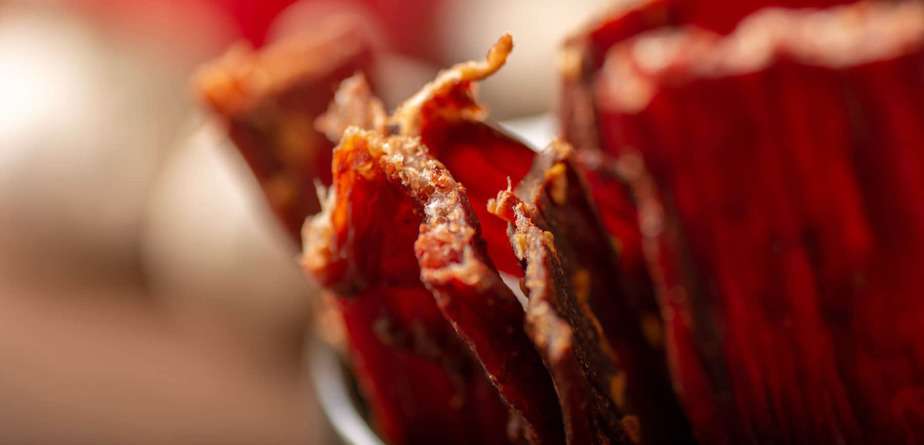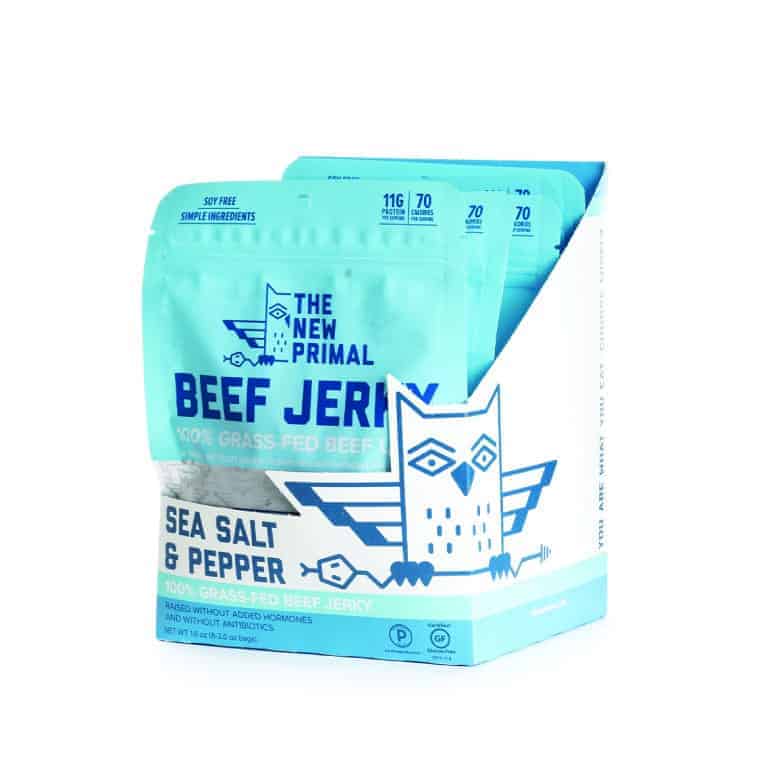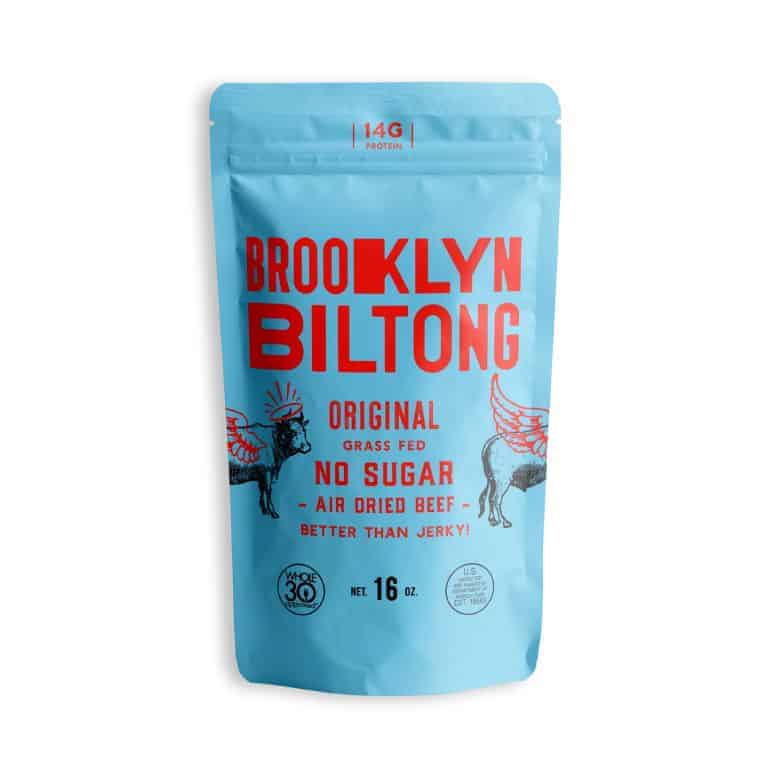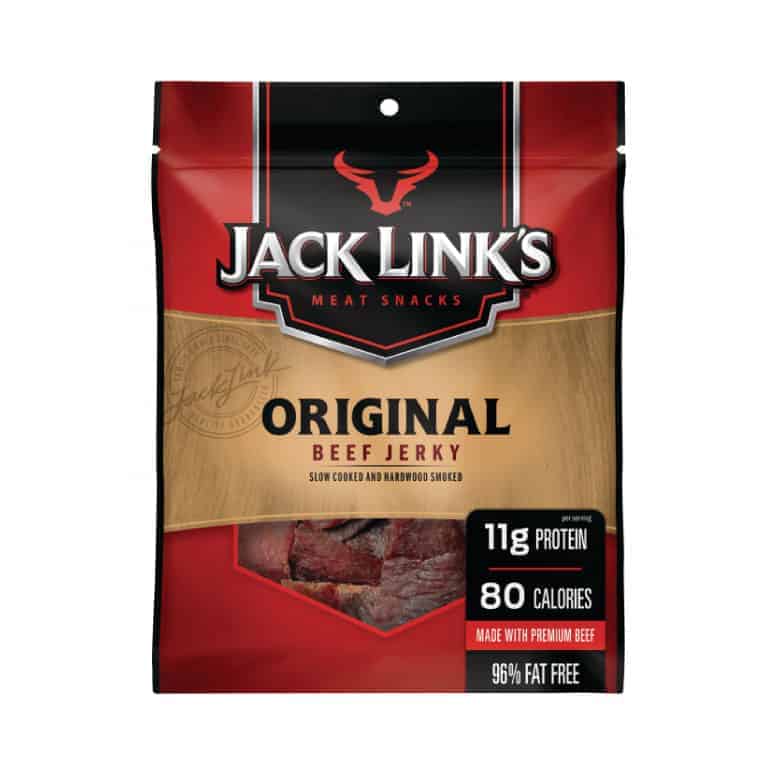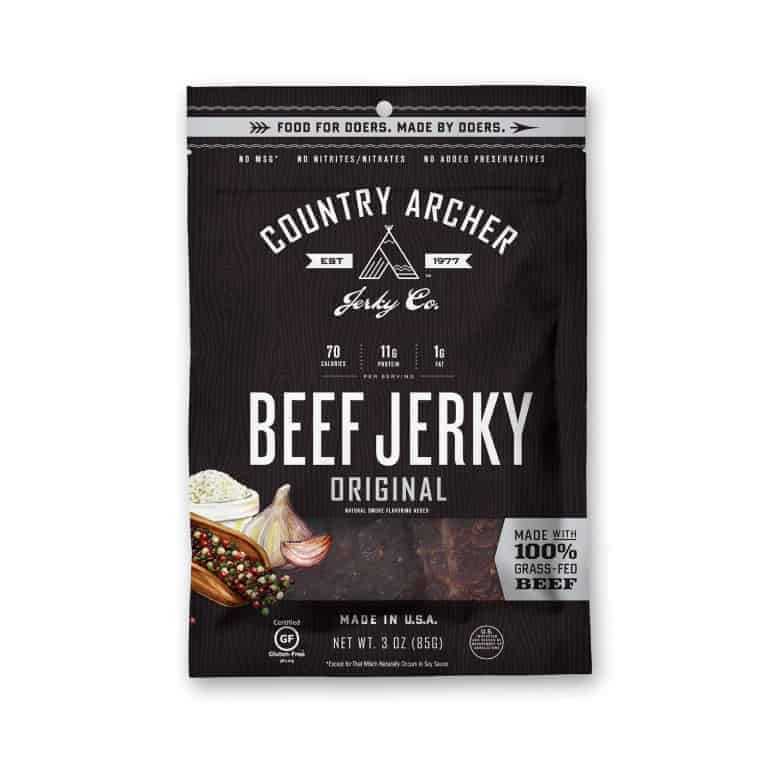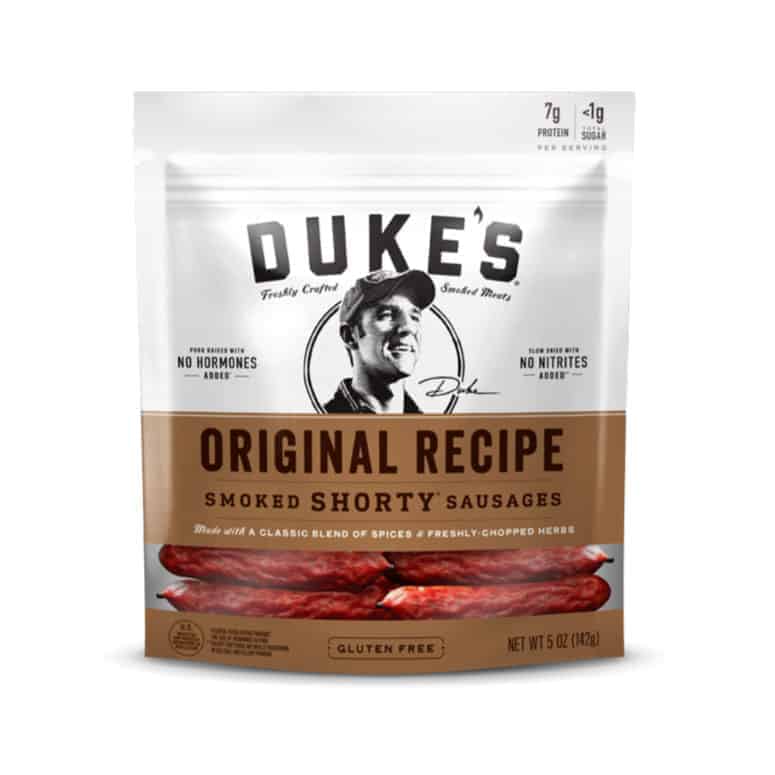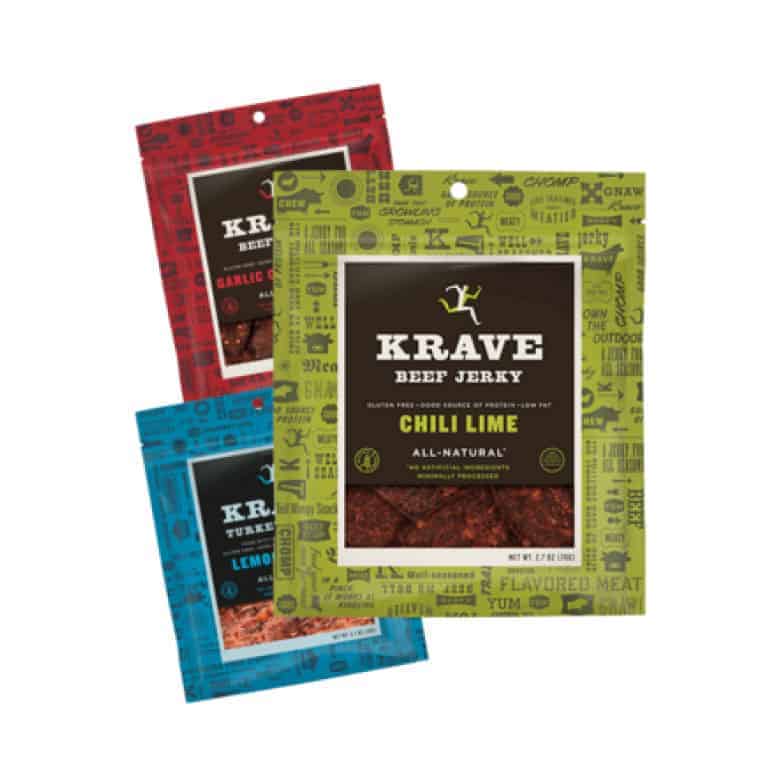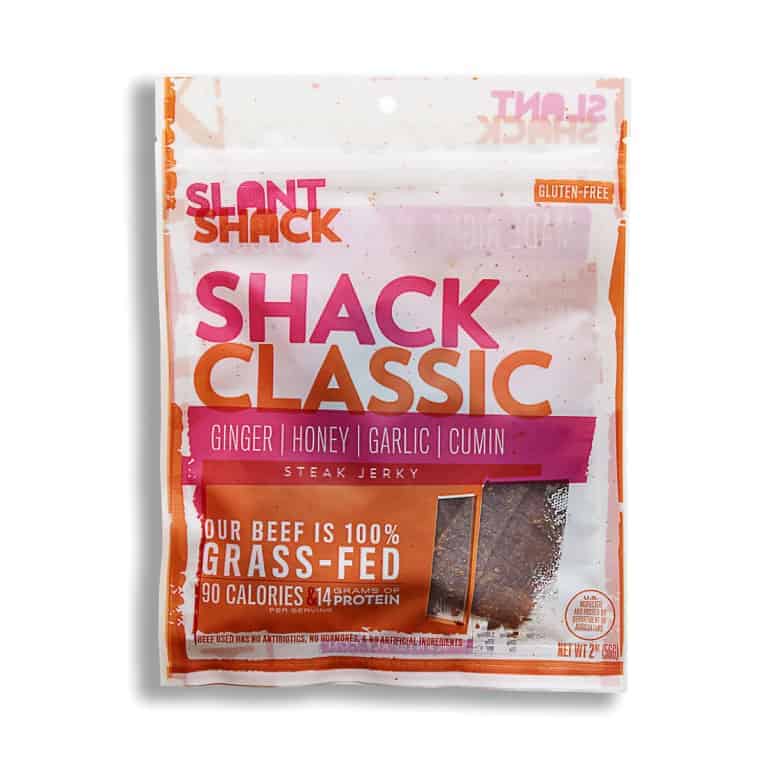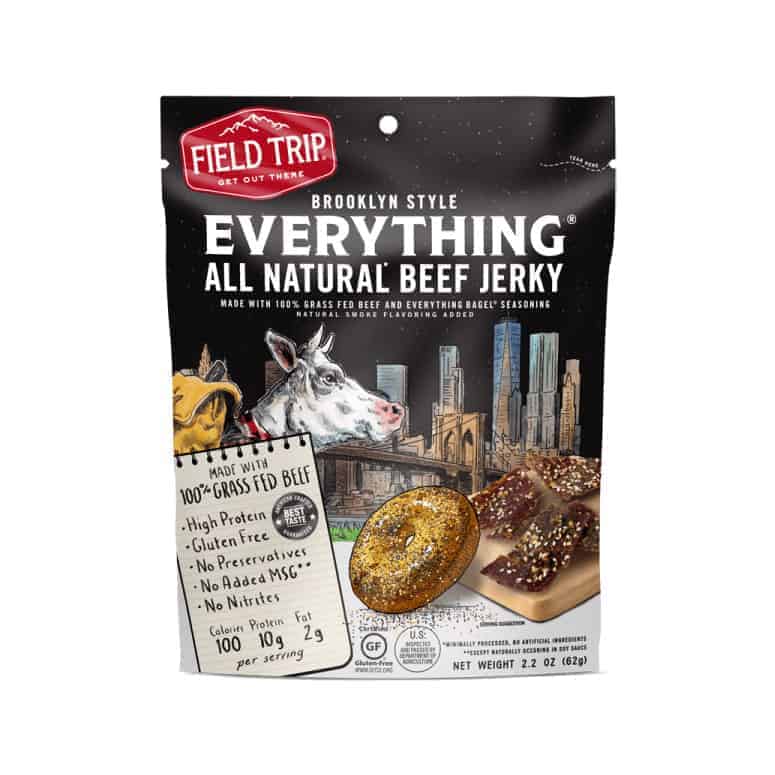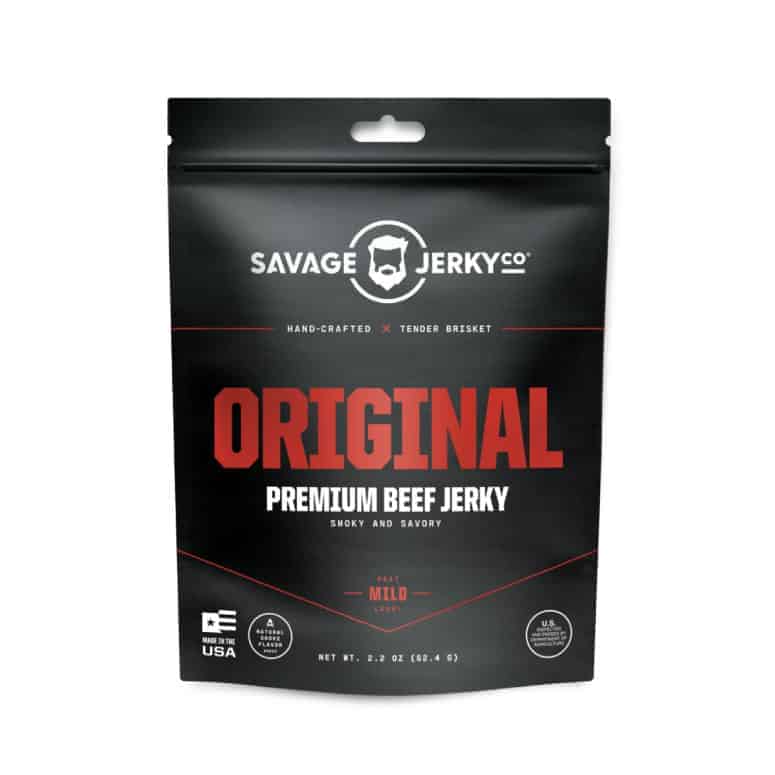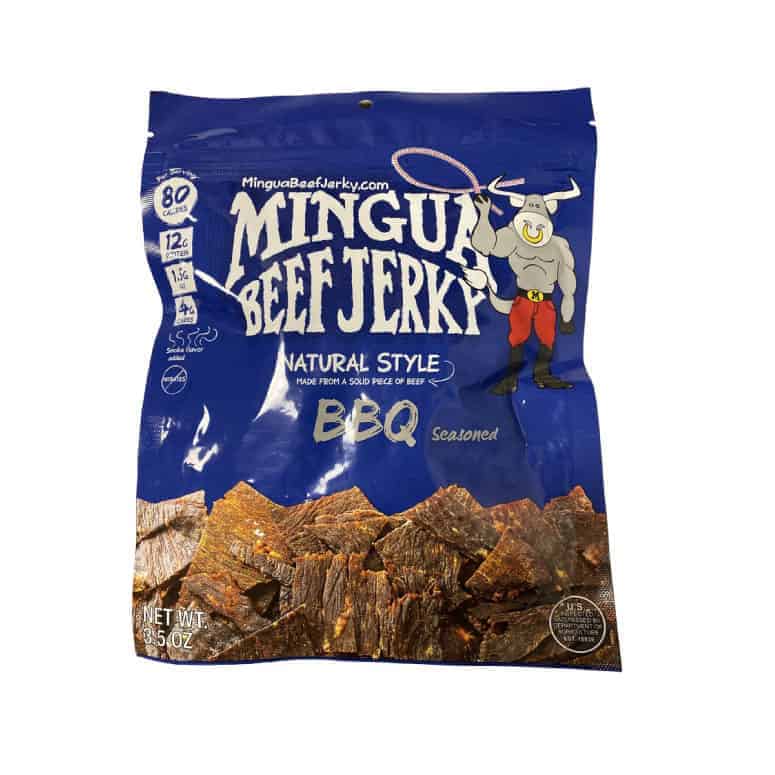I have a finite number of memories from childhood. The easiest ones to recall are mostly snack related. I can still taste the Snickers bars, the sour gummies shaped like watermelons, the Cool Ranch Doritos, and the barbecue-flavored Corn Nuts purchased at gas stations or school vending machines.
I can still remember the struggle of trying to make my “red-flavored” slushies at the movies last until after the previews. I can still appreciate the delicate, subtle flavor that’s created when you mix peanut butter M&Ms and popcorn. And I can still remember the celebratory, lavish feeling of a life of luxury when I was allowed to purchase a bag of beef jerky — the champagne of packaged meat products.
A lot has changed since those early years. I would like to think I make better decisions — especially when it comes to junk food (though I still allow myself all of the aforementioned foods exclusively on a road-trip basis).
But I continue to return to beef jerky because it’s one of the few foods from my childhood that I don’t feel guilty about eating: It’s a low-fat, high-protein snack that’s convenient and tastes delicious. Plus, with so many jerky brands on the market these days, this savory treat has only grown in quality and flavor. To help sort through the wide variety of options, I’ve narrowed down my favorite 10 jerky brands that you can actually feel good about eating.
The Beef Jerky We RAVE About
How to Find the Best Beef Jerky
Studies show that ancient humans were eating Mammoth jerky over 40,000 years ago, but that doesn’t make us jerky lovers Neanderthals. Rather, preserved dried meat has had more time than your average snack to improve its formula, and my favorite jerky companies have come close to perfection.
There are two overarching categories to consider when narrowing down jerky: how the meat is preserved and how the meat is flavored.
Protein Power
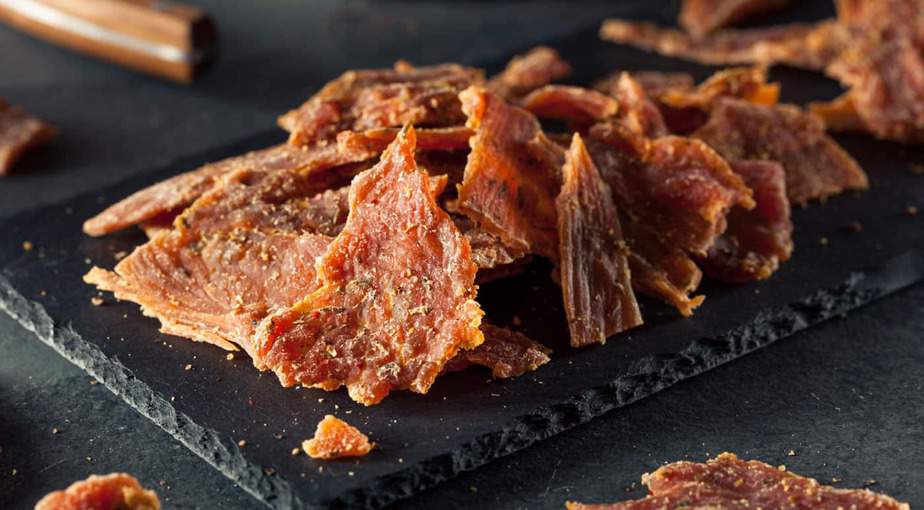
Because jerky is essentially a meat that’s stripped of its fat and then “condensed,” it’s an excellent low-fat high-protein snack. For this reason, many consumers are turning to jerky as a viable source of low-fat protein, and a lot of jerky companies are marketing themselves as a healthy alternative to your typical snack foods.
They’re not entirely wrong, but there are a few things to consider before you blindly grab whatever jerky bag is closest to the register.
Preservation Station
Usually when I’m cooking meat, I’m doing everything in my power (including thoughts and prayers) to prevent it from drying out. When it comes to making jerky, drying it out is the name of the game. The meat is trimmed of its fat and must be dried quickly to prevent bacteria from growing during the cooking process.
Once the meat has been cooked without spoiling, the preservation can really begin. Salt — or nature’s oldest preservative — is often used in addition to chemical preservatives such as sodium nitrate.
“Nitrate” Knowledge
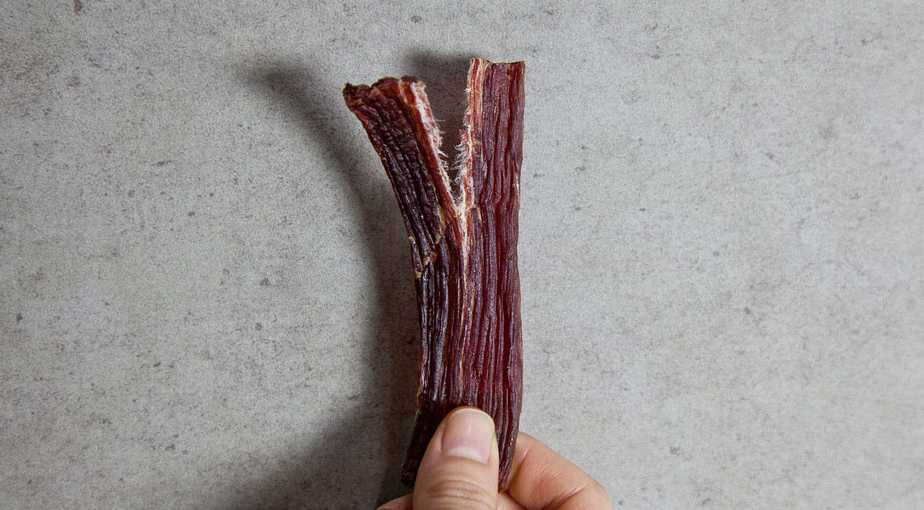
Sodium nitrate has been used to give both taste and color to meat as well as prevent it from going rancid since the early 1900s. It has also been classified as “probably carcinogenic to humans” by the International Agency for Research on Cancer.
How seriously you take is up to you. I personally err on the side of probably not cancerous for my food and beauty products — excluding the articles that come up every so often about wine which I promptly ignore.
To preserve food and still boast the “nitrate-free” label, many processed meat companies (including manufacturers of ham, bacon, hot dogs, and salami) use celery powder or celery juice, which naturally contains a high concentration of nitrates and acts identically to chemical nitrates in your body.
So, if you’re really concerned about health, opt for jerky without sodium nitrate or celery concentrates among the list of ingredients. This will likely be harder to find, have a shorter shelf life, and a higher price tag, but these drawbacks may be worth it depending on your priorities.
Let’s Talk About Salt, Pepper and Sugar
The second thing to consider from a health perspective is salt. Many jerky brands preserve and flavor their products with a whole lot of the white stuff. In fact, a high-sodium bag of beef jerky can have more than four times the amount of salt per ounce than that found in Lay’s potato chips (Matador, for example, contains 710 mg/ounce, versus Lay’s 148mg/ounce).
And, speaking of “white stuff,” a lot of jerky is high in another sneaky and delicious ingredient: sugar. Again, if you’re looking for a go-to snack, you may want to consider a low-sugar (aka low- guilt) jerky.
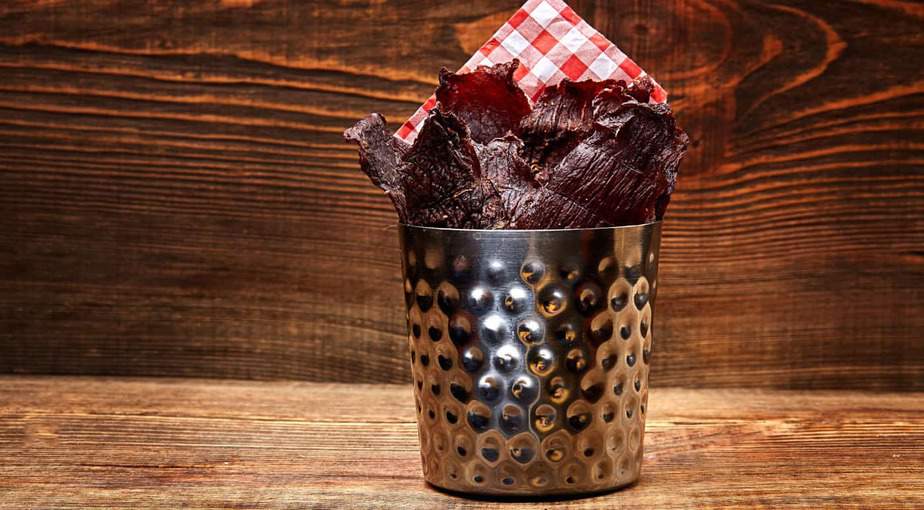
All this is to say that you have some choices when you pick your protein. And, if a healthy snack is what you’re after, you have a few more line items to consider than just the protein content.
Once you’ve considered the health benefits and drawbacks of your jerky — or decided to ignore them altogether because you only live once, right? — there are a few preferential jerky nuances to mull over.
Methodology
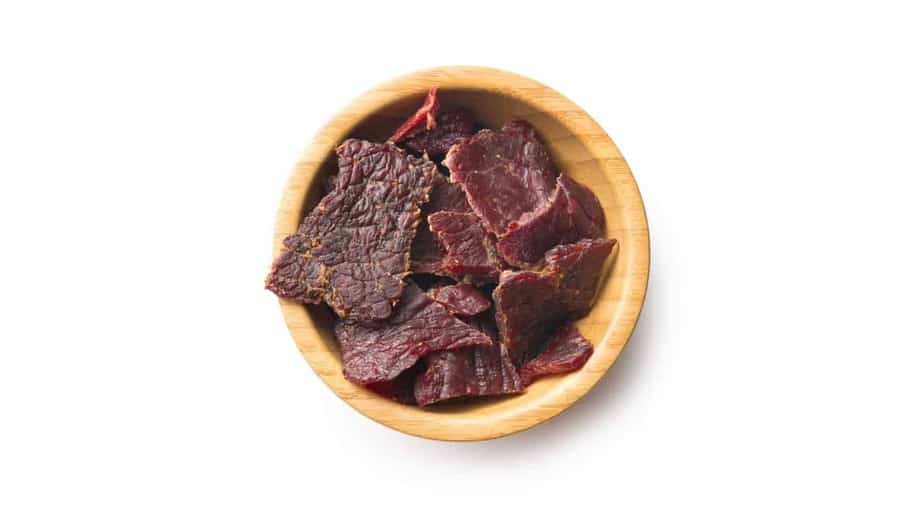
I was tasked with choosing 10 brands that make the best beef jerky here at RAVE, and it was an honor I did not take lightly. Depending on your decision, jerky can be the Cadillac of snack foods or a regrettable roadside snack. I don’t believe in wasting money on bad jerky, so I kept the following in mind while narrowing down my list.
- Quality: Because packaged meat ranges from high-quality on one end of the spectrum to filled with additives and chemicals on the other, jerky can get gnarly quickly if you’re not careful. I prioritized both high-quality meat and ingredients above all else.
- Cost: Jerky is not the cheapest item in the snack food aisle. That said, I kept cost in mind so it can still be justified as a snack food and not make you think, “I might as well have just bought a sandwich.”
- Flavor: I looked for companies that offered the best flavors from spicy and smoky to even sweet — plus everything in between.
- Texture: Beef jerky comes in a variety of textures (dry/moist and tough/soft). In the end, a lot of this comes down to personal preference as well as how long you want your jerky to last. I looked for a pleasing texture that complemented the meat.
- Sodium and Sugar: I’m not against salt — we need it to make food tasty (and also, literally, for survival). I also believe someone who doesn’t like sugar can’t be trusted. With that said, sodium and sugar levels in many jerky brands make it a once-in-a-while indulgence rather than a tried-and-true snack. I looked for jerky with sodium and sugar levels that will make your taste buds palpitate, not your doctor.
- Nitrates: Nitrates weren’t a disqualifying factor. After all, we all need to “pick our poison.” And nitrates are found in a lot of what we eat. I prioritized flavor, but use of nitrates did ultimately count against the best beef jerky brands on my list.
- Convenience: You shouldn’t have to jump through hoops to get a simple snack. I looked for jerky brands that were easy to find so you never go hungry looking for them.
The Best Beef Jerky
The New Primal
I love The New Primal’s jerky for so many reasons. It uses grass-fed beef and simple, high-quality ingredients. It’s also high in protein and low in sodium and sugar. It doesn’t contain any hormones, antibiotics, or nitrates. But what I love most is that it’s so tasty.
If you’re concerned with fat, you might notice this jerky is higher in fat than most of the jerky brands on this list. Before you write them off, however, consider that the fat in grass-fed beef contains healthy omega-3s and CLAs (conjugated linoleic acid), a fatty acid that has actually been proven to maintain leaner body mass and reduced body fat. In other words, this jerky has the “good fat.”
The New Primal isn’t the cheapest jerky on my list, but because of the quality of ingredients, it’s well worth the cost — and more affordable in comparison with similar products. In my opinion, it’s also the best-tasting jerky on this list, which I prioritize above all else. And, it tastes the best without being loaded with sugar and high-fructose corn syrup. So, if you’re looking for a jerky you can turn to time and time again, The New Primal is the bag for you.
Pros
- Hormone free
- No nitrates or antibiotics
- Best taste
Cons
- Not the cheapest
- Higher fat
Country Archer
Country Archer is really good at flavor — especially if you like your food hot and sweet. With flavors like Honey Habanero and Sweet Jalapeno, they’ve figured out how to get you hooked on that sweet and spicy mouth explosion, where all of your taste buds are being activated at once.
I also love that Country Archer uses grass-fed beef raised without antibiotics. What’s more, the brand is committed to using local ingredients whenever possible. And, at around $20 per 16-ounce bag, it’s one of the more affordable jerky brands on my list of the best beef jerky.
Country Archer is moist, which can be a positive or a negative depending on your jerky jam. I prefer a drier jerky, so I ranked this product below The New Primal. It’s also lower in protein than most of the jerky brands on this list, so if protein is of the utmost importance to you, you might want to skip this one. However, if you like your jerky on the juicy side, this might be the meat you’ve been searching for.
Pros
- Low sugar and sodium
- Locally sourced
- Grass-fed
Cons
- Low protein
- Hard to find
Brooklyn Biltong
Not only is this jerky sugar and free of artificial preservatives, the company also donates 10% of its proceeds to fighting homelessness. Talk about a jerky you can feel good about eating! The origins of Brooklyn Biltong started in South Africa, and the product is similar to jerky but with a few key differences. Mainly, the meat is hung to dry and cured without heat (traditional jerky is cooked on a rack). This means the meat is usually a thicker cut, and vinegar is used as a preservative in addition to salt.
It’s also never smoked and tends to be less dry than jerky, so if you love that classic dry smoky flavor of jerky, Brooklyn Biltong might be the right one for you. The process also results in a meat that’s slightly higher in fat than traditional jerky. That’s well worth taking into consideration if fat content is a concern. And, as you can probably guess from its artisanal vibe (“Brooklyn” is in the name for goodness sake), you know it’s not going to be cheap.
That said, I love Brooklyn Biltong for a few reasons. First, they use grass-fed beef, meaning the cows are being fed their natural diet resulting in meat that is of a higher quality. It also uses incredibly simple ingredients: only apple cider vinegar, water, salt, coriander, pepper, and allspice, so you know there are no sneaky ingredients hiding in your bag.
If you’re looking for that classic childhood jerky, this brand is probably not what you’re after. But, if you’re looking to upgrade to a healthy adult-friendly alternative, consider trying Brooklyn Biltong!
Pros
- No sugar
- Grass-fed beef
- Simple ingredients
Cons
- Different flavor
- Higher fat
- Expensive
Duke’s Meats
Duke’s offers something a little different: a chunky, chewy alternative to traditional dry jerky. The brand uses grass-fed beef, but what it claims really sets the product apart is what goes on the meat—namely that it only uses fresh ingredients (rather than just dried spices), and the brand keeps the sugar content low.
Because the texture is slightly different from a traditional jerky, Duke’s isn’t for everyone. They’re also focused on smoking meats, so if you prefer your jerky without a smoky flavor, you should probably pass.
For me, I enjoy Duke’s smoky flavor and texture as an alternative to more traditional dry jerky. if you’re looking for something that’s high quality and a slightly new experience, I encourage you to try Duke’s.
Pros
- All natural
- Grass-fed
- Low sugar
Cons
- Different texture
- Expensive
- Too smokey for some
KRAVE
Krave is the jerky for everyone (except vegetarians I suppose, but I doubt they’re reading this article). It’s gluten free, uses all natural ingredients, and comes in a wide variety of flavors from Chili Lime to Black Cherry BBQ — along with standards like Sea Salt Original and Sweet Chipotle.
Plus, for artisanal jerky, the brand has done an excellent job of putting itself out there: You can find Krave’s products in a number of national chain markets so you don’t have to wait three weeks to get your fix.
Krave’s jerky comes in a smaller bag, but the price per ounce is comparable to other artisanal competitors. In other words, it’s not the cheapest jerky on the market, but I prefer the smaller size because it keeps me from overeating. It’s also very high in sugar, so if you’re concerned about your sugar intake this isn’t your bag.
What put this jerky on my top ten list was not only its availability and interesting all-natural flavors but for the taste. The meat is tender and packed with flavor. So, if you’re okay with a higher sugar content, Krave’s jerky is an excellent choice.
Pros
- Easily available
- Variety of flavors
- Gluten free
Cons
- Expensive
- High sugar
- Smaller bag size
SlantShack
If you want a cured, dried meat, but you still want to keep it fresh, SlantShack is the jerky for you. What I love about this jerky brand is its commitment to sustainable practices and offering the highest-quality meat. SlantShack only use free-range grass-fed beef and collaborate with suppliers to ensure its cows are raised humanely without antibiotics or hormones. What’s more, it uses organic spices and non-GMO marinades, making for a delicious jerky that’s low in sugar, low in guilt, and high in protein.
So why isn’t it higher on my list? One main reason: availability. SlantShack makes its jerky to order, so it’s always fresh. That sounds like a positive until you have to wait 3 weeks to get your bag. What’s more, it’s only sometimes available on the brand’s website and many of its products are sold out. But, it is carried at some specialty supermarkets, and if you’re lucky enough to get your hands on this jerky, you can rest assured that the quality is well worth the price.
Pros
- High quality meat
- No hormones or antibiotics
- No GMOs and low sugar
Cons
- Hard to find
- Hard to order
- Long wait time
Field Trip Jerky
If you’re in need of extra protein, look no further than Field Trip. Made for hikers and boasting a whopping 14 grams of protein, this jerky is not messing around when it comes to substance. What’s more, it packs a punch without any added refined sugars, artificial preservatives, or artificial ingredients. And, offering fun flavors like Everything Bagel and Maple Barbeque—and at an affordable price tag—you’ll probably want to try a few.
Although they use only all-natural ingredients, they don’t tell you much about their meat. In fact, given its high-protein, low-fat, and low-sugar content, this product would likely be higher on my list if they gave me more details about their cows. But, if protein is your main goal, and you still want to go au natural, consider trying Field Trip.
Pros
- High in protein
- Affordable
- All natural
Cons
- Ingredients unknown
- Hard to find
- No details about meat
Savage Jerky Co.
If you’re looking for spicy, Savage Jerky was made just for you. It’s not afraid of a little kick when it comes to its meat. In fact, it even offers a Carolina Reaper flavor, which I can’t personally comment on due to my crushing fear of the repercussions. That said, it does boast pushing more than 2 million Scoville units, which I take to mean torturous enough to more than satisfy your average spice lover.
And, if spicy isn’t your M.O., Savage offers a wide variety of more traditional flavors from a sweet Teriyaki to a simple Cracked Pepper & Sea Salt.
Unfortunately, this jerky is harder to find; you’ll most likely have to order it online depending on where you live. Though not crazy expensive, it’s also not cheap. What really put this jerky lower on my list, however, was its lack of transparency regarding its beef. I assume if a company is using high-quality, grass-fed beef, it’s bragging about it. Savage does no such bragging, and if I’m going to pay a high price for jerky, I want to be sure the meat is worth the expense. That said, if flavor is your highest priority, Savage is worth a try.
Pros
- Spicy
- Dry (in the right way)
- Tasty
Cons
- Hard to find
- Expensive
- Ingredients unknown
Jack Link’s Jerky
I think of Jack Link’s as that classic Costco Jerky: the kind your mom or dad would bring home from the store in a year’s supply box. And for good reason: Unlike my millenial counterparts, my parents weren’t willing to forgo a retirement plan to spend more than $40 for a 16-ounce bag of jerky.
Price aside, I think this jerky is pretty good. It’s a tad on the chewy side, so if you like it dry, it will likely disappoint. Some of the flavors also have some unfortunate ingredients such as high-fructose corn syrup, and the meat isn’t as high quality as some of the more expensive brands. But, if you opt for the “original” flavor rather than BBQ, you’re looking at a relatively low-sodium, low-sugar, low-fat snack that’s high in protein.
Another huge plus with Jack Link’s is its availability. Unlike some of the more artisanal brands, you can find this jerky basically anywhere that sells snacks. I don’t think this is the absolute most delicious jerky on this list of best beef jerky. But, if you’re looking for a reliable jerky that doesn’t cost a fortune, Jack Link’s is a solid choice — particularly opt for the lower-sugar original flavor.
Pros
- Inexpensive
- Easily available
- No artificial nitrates
Cons
- High-fructose corn syrup
- Chewy
- Lower quality
Mingua Beef Jerky
If you’re a tough guy or gal looking for jerky that matches your hard exterior, consider Mingua. I think of Mingua as the jerky for cowboys: It’s an old-fashioned, straightforward jerky whose recipe has been passed along for generations.
It satisfies that “hard to eat” texture that lovers of classic jerky might seek out. It’s tough and chewy, so the bag takes a while to get through — perfect for a road trip or a long night studying.
Like others on this list, the brand doesn’t provide any information about the beef it uses or the ingredients. But, if you like it hard and cheap (so to speak), Mingua might be the jerky for you.
Pros
- Tough
- Classic
- Inexpensive
Cons
- Ingredients unknown
- Questionable ingredients
- Too tough for some
How is beef jerky made?
Though manufacturers will use slightly different processes — such as smoking and using signature spice blends — the basic process of making beef jerky starts with a piece of lean meat. Fat prevents the meat from preserving, so as much fat as is removed from the meat before it is then is thinly sliced.
Next it’s marinated for flavor and slowly cooked at a low temperature. Finally, it’s dehydrated and packed.
Is beef jerky bad for you?
The short answer: it depends. The amount of “stuff” in a beef jerky recipe varies by company: the products used, the quality of the meat, how much sodium it contains, etc. Many beef jerky brands are high in sugar, sodium, and contain MSG (the jury’s still out on whether or not the latter is “bad for you,” but no matter what you believe it’s important to be aware of what you’re consuming). Furthermore, many companies use beef that’s been raised using hormones — not to mention they’re far from being grass-fed and organic.
With that in mind, beef jerky has been hailed as a healthy snack that’s high in protein content and low in fat. So, if you’re especially health minded, you’ll want to take a peek at the ingredient list and nutrition information located on the back of the package. If the brand has a high-sodium content or ingredients that you can’t pronounce—that is a red flag health-wise. And, as with any snack food, it’s always best in moderation.
How should I store beef jerky?
Although beef jerky is made to be shelf stable and essentially spoil proof, jerky can go bad like any other food item. The trick is to treat it like any other food: If your jerky didn’t come in a resealable bag, store it in a vacuum-sealed container, a plastic bag, or tightly wrap it in plastic wrap to limit its exposure to air. Make sure to keep it dry and out of humidity. If you notice moisture start to build up, pat it dry with a paper towel, as mold can sometimes form on it.
You can also choose to store your jerky in the freezer or refrigerator, which will increase its shelf life (but make it less available for immediate consumption). My recommendation: Eat it right away while it’s fresh!
I only eat kosher or halal meat. Can I still eat beef jerky?
Even though it says “beef” jerky, I would hesitate to endorse many of these brands if you only eat kosher or halal meat. The good news is that you’re not alone! Because of the high demand, many beef jerky brands advertise their kosher or halal status. Just keep an eye out for the special certification on the packaging.
